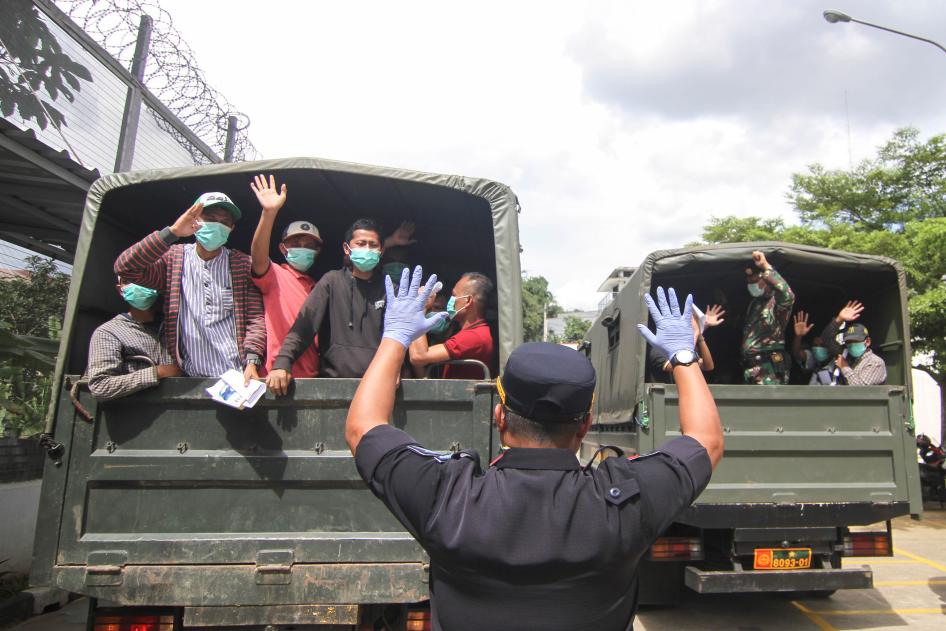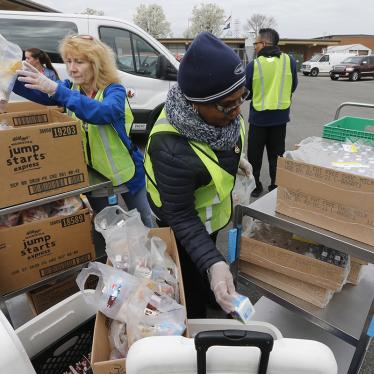(New York) – Asia’s overcrowded and unsanitary prisons, jails, and detention centers are at grave risk of COVID-19 outbreaks that threaten the physical and mental health of both detainees and staff and the broader population.
To stem COVID-19 outbreaks, Asian authorities should immediately release prisoners detained for exercising their basic rights, without charge, and for low-level and nonviolent offenses. The authorities should also consider releasing older prisoners and those with underlying medical conditions who would be at greater risk if they became infected.
“A major crisis is brewing in Asia’s overcrowded prisons and jails,” said John Sifton, Asia advocacy director. “Governments in Asia need to move quickly to reduce detention populations by releasing people who shouldn’t be in custody the first place, like political prisoners and those jailed for minor offenses.”
Five of the 10 countries with the largest prison populations are in Asia. China’s official prison population is the second largest in the world, even without counting the one million held in “political education” camps in Xinjiang, and unknown numbers in “black jails,” “custody and education” facilities, and other forms of arbitrary detention. India, Thailand, Indonesia, and the Philippines are also in the top ten.
Many prisons and jails in Asia are overcrowded, according to the Institute for Crime and Justice Policy Research, with Indonesia, Cambodia, and Bangladesh prisons at over 200 percent capacity. The Philippines has a 464 percent overcapacity rate, the most overcrowded prison system in the world – some of its prisons are over 500 percent capacity.
The large percentage of pretrial detainees in many Asian countries is a major factor in the overcrowding. In the Philippines, for instance, 75 percent of detainees have not been convicted of any crime, and many wait years before going to trial. In Bangladesh, pretrial detainees make up approximately 80 percent of detainees; in India, the number is approximately 67 percent.
In the Philippines, crowding in jails has grown worse in recent weeks, as authorities have made 17,000 new arrests for curfew and quarantine violations – including many children. These facilities normally provide poor health care. In the national penitentiary near Manila, 5,000 inmates die each year – one in five. Yet the government has taken no significant steps to avert an impending crisis other than to ban jail visits and send sick staff to home quarantine.
Myanmar is especially ill-equipped to deal with an outbreak of coronavirus, whether among the general population or in overcrowded prisons. The country’s entire system of almost 100 prisons and labor camps has only 30 doctors and 80 nurses, according to the Assistance Association for Political Prisoners (Burma).
On March 25, the United Nations Subcommittee on the Prevention of Torture called on governments to “reduce prison populations and other detention populations wherever possible,” taking full account of non-custodial measures provided for in the United Nations Standard Minimum Rules for Non-custodial Measures, known as the Tokyo Rules.
The UN High Commissioner for Human Rights, Michelle Bachelet, has also called on governments to reduce detainee populations as part of overall efforts to contain the COVID-19 pandemic: “Now, more than ever, governments should release every person detained without sufficient legal basis, including political prisoners and others detained simply for expressing critical or dissenting views.”
In addition to those who should be released immediately, such as people in pretrial detention for low-level or nonviolent offenses or who do not present a significant flight risk, governments in Asia should consider alternatives to detention for:
- People at higher health risk, such as older people, pregnant women and girls, people with disabilities that may place them at greater risk of COVID-19 complications, and people with compromised immunity or chronic conditions such as heart disease, diabetes, lung disease, and HIV. Assessments should determine whether their health can be protected if they remain in detention, and take into account factors like time served, the gravity of the crime, and the risk their release would represent to the public.
- People with care-giving responsibilities accused or convicted of nonviolent crimes, including women and girls incarcerated with their children and prisoners who are primary caregivers to children;
- People in semi-open facilities who work in the community during the day;
- People convicted of crimes close to the end of their sentences; and
- Other people whose continued detention is unnecessary or disproportionate.
Governments have an international legal obligation to protect and treat the inmates who remain in custody. They should draft and implement comprehensive plans to prevent and respond to a COVID-19 outbreak in detention facilities that do not rely on simple lockdowns but provide measures to protect the physical and mental health of detainees. Prisons should protect inmates and staff while allowing detainees access to family and legal counsel.
International guidance says the most important approach for detention centers to prevent transmission is to impose “social distancing,” defined as allowing two meters of separation at all times among detainees and staff, including during meals and within cells. It is also critically important to isolate people at high risk, those testing positive or with symptoms consistent with COVID-19, and their close contacts. However, such measures are not feasible in Asia’s overcrowded prisons, reinforcing the need for authorities to immediately reduce prison populations.
Plans to mitigate risk in prisons should also include ensuring access to potable water; providing hygiene products and information about the disease to detainees; thoroughly and regularly disinfecting cells in police stations, courthouses, jails, and prisons; screening and testing protocols for prison staff, visitors, and detainees; avoiding transferring detainees between facilities when possible; and ensuring health care and mental health services for all detainees, particularly those infected.
All plans should include attention to female prisoners and prisoners with disabilities, who have unique health needs and whose interests are often marginalized within prison systems.
Prisons and detention centers across Asia should develop plans to isolate or separately house particularly vulnerable detainees and those testing positive and their close contacts, based on the best available evidence about the effectiveness of the measures. Such measures should be proportionate, and detainees should not experience such measures as punitive, or they may delay notifying prison staff if they experience symptoms. The authorities should also take into account the impact that isolation may have on detainees’ mental well-being.
Prisons and detention facilities are not isolated from their communities, but consist of staff and other workers, as well as new and released detainees, who go back and forth between the facilities and their homes. Reducing the prisoner population through releases prior to widespread transmission, including by placing prisoners in temporary offsite quarantine or self-isolation as necessary, will reduce the risks to prisoners, staff, and to surrounding communities, Human Rights Watch said.
“Reducing overcrowding is critical to averting a health crisis both inside and outside prisons and jails throughout Asia,” Sifton said. “Without protecting prisoners’ health, Asia’s governments will be unable to stem this pandemic.”







